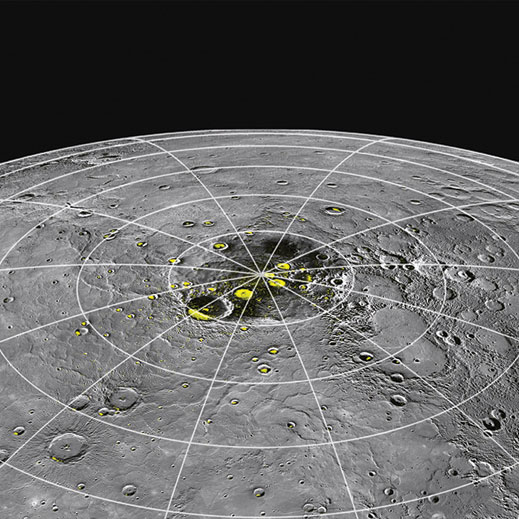Mercury, the innermost planet in our solar system, revolves around the sun in 88 days, making a tight orbit that keeps the planet toasty. Surface temperatures can reach a blistering 425 °C—hot enough to liquefy lead.

Now researchers from NASA, MIT, the University of California at Los Angeles, and elsewhere have discovered evidence that the planet may harbor pockets of water ice, along with organic material, in several permanently shadowed craters near its north pole.
The surprising discovery suggests that both ice and organics, such as carbon, may have been deposited on Mercury’s surface by impacts with comets or asteroids.
“We thought the most exciting finding could be that this really was water ice,” says Maria Zuber, a professor of geophysics at MIT and a member of the research team. “But the identification of … material that may indicate complex organics makes the story even more thrilling.” The team published its results in the journal Science.
The possibility of ice on Mercury is not new: in the 1990s, radar observations detected bright regions near the poles that scientists believed could be signs of either water ice or a rough surface. However, the evidence was inconclusive.
To get a clearer picture of Mercury’s poles, Zuber and her colleagues analyzed observations taken by NASA’s Messenger (Mercury Surface, Space Environment, Geochemistry and Ranging) mission, which must cope with the sun’s intense radiation—and the havoc it wreaks on electronics—to take measurements. That probe’s laser altimeter has been mapping the planet’s topography since April 2011 by shooting pulses of laser light toward the surface and measuring how long they take to bounce back. Comparing the energy of the original pulse with the amount of energy that bounces back also let researchers determine the reflectance of the surface.
At first, the results were puzzling. The laser altimetry measurements showed areas of surface brightness at northern latitudes, matching the previous radar findings and indicating the possible presence of reflective ice. However, just south of two craters that were bright by both measures, other craters appeared dark with laser altimetry but bright in radar.
The observations “threw us off track for a long time,” Zuber says, until UCLA team member David Paige developed a thermal model of the planet, simulating the sun’s illumination and precisely determining Mercury’s temperature at and below the planet’s surface.
Results indicated that the unusually bright deposits corresponded to regions where water ice was present at the surface; ice was also present in the laser-dark and radar-bright regions, but it was up to a meter below the surface. The underground ice was detected by radar but not by surface laser reflectance. Zuber says this ice may be insulated by the organic materials detected with it, preventing it from melting.
Keep Reading
Most Popular
Large language models can do jaw-dropping things. But nobody knows exactly why.
And that's a problem. Figuring it out is one of the biggest scientific puzzles of our time and a crucial step towards controlling more powerful future models.
How scientists traced a mysterious covid case back to six toilets
When wastewater surveillance turns into a hunt for a single infected individual, the ethics get tricky.
The problem with plug-in hybrids? Their drivers.
Plug-in hybrids are often sold as a transition to EVs, but new data from Europe shows we’re still underestimating the emissions they produce.
Stay connected
Get the latest updates from
MIT Technology Review
Discover special offers, top stories, upcoming events, and more.